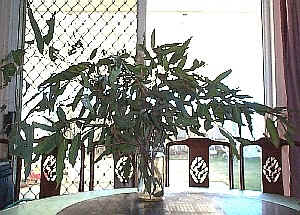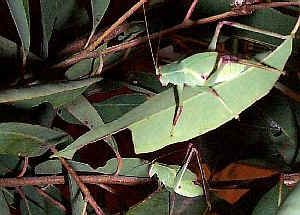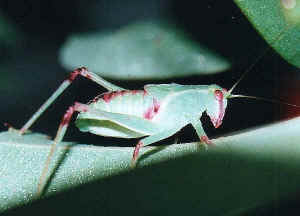Gum Leaf Katydid - Caedicia sp.
Family TETTIGONIIDAE
This page contains pictures and information about the Gum Leaf Katydids that we found in the Brisbane area, Queensland, Australia.

- Female, 50mm
The Katydid
Adult Gum Leaf Katydids are resemble gum leaf, both in shape and colour. Some adults may have some brown markings on their legs. Their front wings look exactly a gum leaf, with the thick white vein at the middle.
The older nymph looks similar to adult except wingless and has brown patterns on its body and legs. The brown patterns are resembled the brown spots on the gum leaves. The young nymphs look quite different from their adults, instead they look like large brown ants.. Their brown colour gradually disappear when grow up.
They feed on eucalypt tree leafs. Like most of other katydids, they do not cause much, if any, economic damage.
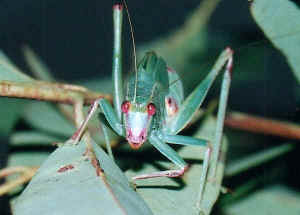
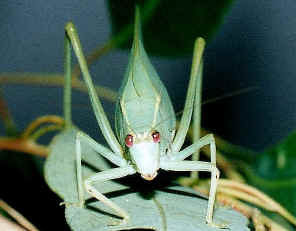
- Last instars and adult
- Their antennae is longer than their body. We noticed that if its antennae is broken, it will re-grow to normal length after next moulting.
Their rear pair of legs are longer and stronger than the front and mid pair of legs, but they look thinner than the hind legs of grasshoppers. We seldom saw them jump. Instead, they kick with their spiny hind legs if disturbed. All their legs are armed with spins.

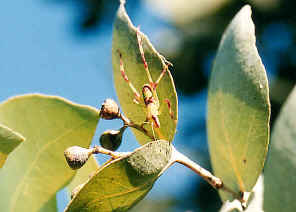
- Pictures taken at Wishart Outlook Bushland 18 Feb 01 and 15 May 01, both have body length 15mm. At that time we did not recognize it was the nymph of Gum Leaf Katydid.
Their compound eyes are relatively small, with poor eye sight. Their simple eyes can hardly be seen. From the response shown by their antennae, they can see my hand within 30cm. But they seems cannot distinguish my hand from a branch of leaf. Their antennae are located on the head in front of the compound eyes. The antennae are segmented and are used as organs of smell and touch. They have strong chewing mouthparts for eating the gum tree leafs, which is very tough to our standard.
Laying Eggs
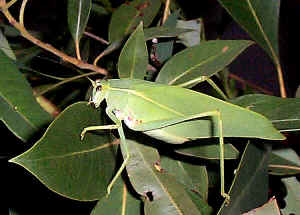

- We found a Gum Leaf Katydid feeding on a gum tree at night in Wishart bushland during late summer. We took it home for a few days. After two days, she started to lay eggs. Totally she lay three batches of eggs before we put it back to the bush. The picture shows she was laying the first batch of eggs on the edge of a gum tree leaf.
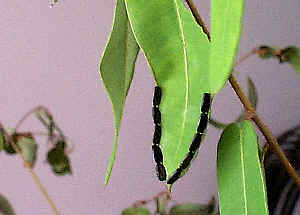
- The katydid laid ten eggs along the edge of a gum tree leaf. The eggs were dark brown in colour, in oval disk shape with 4mm in length. The eggs look like plant seeds. The katydid lay totally three batches (10, 8, 9 in qty) of eggs every alternative night.
- The following pictures show the katydid laid eggs on a gum stem.
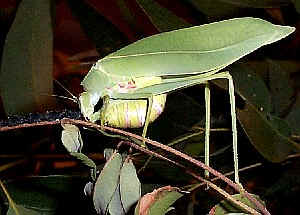

- She first cuts an opening on the stem using her sharp ovipositor, into which she lays the hard, black and disk-like eggs.
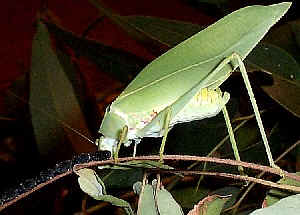

- She carefully glues their eggs in row, then she repeats the whole procedure for another egg.
- We noticed one thing quite interesting. We kept the katydid openly in our room corner on a branch of gum leave. The katydid had no problem on staying there for the whole day. But every time after she laid her eggs, she had the very strong intention to move to another location, even if we try to stop it. After it flied to the other corner of our room, we put it back to the same branch of leave, then it will stay there comfortably until laying the next batch of eggs. We guessed this is the instinct that naturally selected to avoid too many eggs laid at the same location.


- The female lay eggs on leafs and stems. Their ovipositor are short when compare with other species of katydids. But it is strong and sharp, as shown in the above picture. It is used for cutting the surface of the leaf or stem, into which the hard, black and disk-like eggs are laid. Then the female carefully glue their eggs in row.
Because they lay eggs on plants and their eggs look like plants materials, katydids are sometimes distributed by nursery stock.


- We found some katydid eggs in wild on mid winter. If we had not seen the katydid laying eggs, we can hardly guess those black seeds like things are the eggs of insects.
From Nymph to Adult
We found a Gum Leaf Katydid nymph on a gum tree in early winter. At that time we did not know they are the Gum Leaf Katydid. We wanted to know what would they be when they grow up. We take them home and watch them grow. We put them openly on a few branches of gum tree leafs, held in a water bottle. We replaced with flash branches every week. The next week We found another nymph and we put them together.
Both of them were found on the same type of gum tree and they were sitting on leafs about one meter above the ground. They did not eat much, less than a leaf per day. We sprinkle water on the leaves twice a day. The insects moved and hided under leaves to avoid getting wet, then came up and drank the water.
After few weeks later, with about two or three times of moulting, we saw that one katydid nymph was male and the other female. It is not too difficult to tell, female has the distinctive ovipositor for laying eggs which the male does not have.
The two katydids seem like to eat the leafs on the tips of the branch. They will eat about 1/8 to 1/4 of the leaf per day. Sometime they choose only brown part of the leaf to eat. They do not eat much, spend most of the time sitting on a leaf.
- The following pictures recorded the grow rate of the two Katydids.


- 21/05/01, 15mm, just after moulting, eating their own old skin.


- 23/06/01, 18mm, still looked very different from adult.
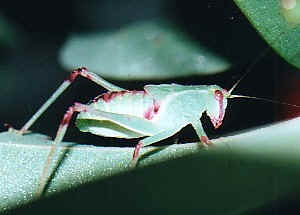

- 08/07/01, 20mm, with small wing buds.

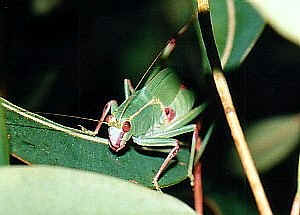
- 15/07/01 22mm, with larger wing bubs, look similar to adult.

- 08/08/01, finally, after the last moulting, she became an female adult. The male became an adult three days later. She did the last moulting at evening and the male did it at mid-night. The moulting took a few hours. The above picture show she was pumping blood into her wings to extend them before hardening. Katydid moulting is always done in a hanging position. In this stage, if the katydid were drop onto the ground or any of their body parts were entangled, her body shape would not be normal.

- After all body part are hardened and ate the shed skin and she became an adult .
We can find the adults and nymphs of different stages throughout the year in Brisbane. The Gum Leaf Katydid does not have seasonal growing cycle. This is different from the Giant Grasshoppers, they have the one year growing cycle and we will see only adults in winter.
The First Instars
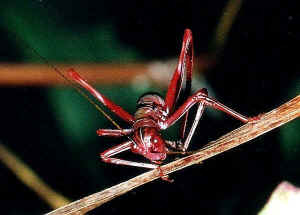

- We will never guess this is the first instars of the Gum Tree Katydid until we saw their development. They hatched on early summer. Some of them are dark brown and some are black in colour. They are quite large as the first instars, about 10mm in body length. They just look like large black ants. This is an advantage to the young instars for most predators will avoid armed ants. They have very long antennae, about four times their body length. They are very active, running and jumping between plants.

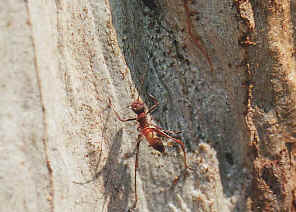
- A few days to a week later, after their first moulting, they have more green colour patterns on their body. Their body length becomes 12mm. And they look more alike their parents. The second picture above was taken on a gum tree trunk in late spring. The young katydid wandering on ground and tree trunk. Look like an ant and this is sure an advantage.
Their Love Song
Katydids and crickets are the major noise source in the field at night. The male produce sound, known as stridulation, to call for the female. They usually sing for the whole night. Both female and male have their hearing organs on their front pair of legs. Gum Leaf Katydid produce the sound by rubbing their two front pair of wings, or tegmen, together. There are the raised vein on the underside of both tegmen. By rubbing them together, just like rubbing the teeth of two combs against each other.
The male katydid that we keep sings not very often, about two to five times from evening to twelve o'clock before we sleep. Every time is just three 'did-did-did' sounds, and never sing when I come close. So I do not have the sound record, like what we have done for the Mole Cricket.

- Male Katydid, notice the hearing organs on its front pair of legs. If you see carefully, on its tegmen, the area brown in colour, you may see the pattern reflected under side. It make the sound by rubbing them together.
Different species produce different pattern and different frequency of stridulation. This is the common way of katydids and crickets making the sound. However, the Mole Crickets produce the sound in the different way.
Typical Insect Leg
- Notice the openings on its front legs, known as tympana, which is the sound receptors. They are the organs function like our ears, are to hear. The female katydid uses them to locate the males by their love songs.

Let's have a closer look of the katydid front leg. The drawing shows the foreleg of the katydid, which is the typical example of insect legs except there is the special organ tympana. The tympana is only found on katydids' and crickets' forelegs, and not on other legs nor on any legs of other insects.
All insects have three pairs of legs. These legs can be variously modified depending on the type of insect. Basically each leg has 6 segments. The coxa connects the leg to the thorax. Leading outward are the segments: trochanter, femur, tibia, and tarsus. The tarsus comprised of 3-5 very small segments. At the end of the last tiny segment is the claw. There are usually spines on the tibia. The tarsomere on the tarsus is the part in contact with the ground.
For more information on insect body parts, please see the Insect Scientific Page.
Camouflage
We found that they usually active at night. Actually their 'active' in not really active. They feed on leaf and walk around within a small area. In day time they usually stand still on a leaf near the tips of the branch. Usually it will take us minutes to find them although we know where to look for them.
Gum Leaf Katydid like to hide on the tips of the branch, but not on the top of the tree. This may help them to avoid the predation from birds. This also explain why we can find them easier than those species hiding on the tree top.
We notice a interesting way of the Gum Leaf Katydids handling their droppings. Most insects, such as the Giant Grasshoppers, just let their droppings drop vertically onto the ground, or the leave just under them. So sometime we can use their droppings to locate them. For the Gum Leaf Katydids, we notice that every time, when their droppings are half way out,. they use their hind leg, left of right, to kick them far away. This will sure help them to hide away from the predators. This habit is somewhat similar to the Goliath Stick Insects. To see another way of dropping handling, please click here.

- The Katydid's dropping, 3mm in length, evenly distributed on the floor, not just concentrated on one spot under the insect.
They always eat the shard skin after moulting. So that their predator cannot find them by their skin.
Questions for Discussion
Why it is the male katydid who made the calling, and not the female?
